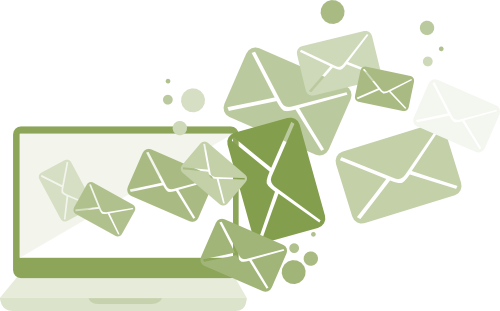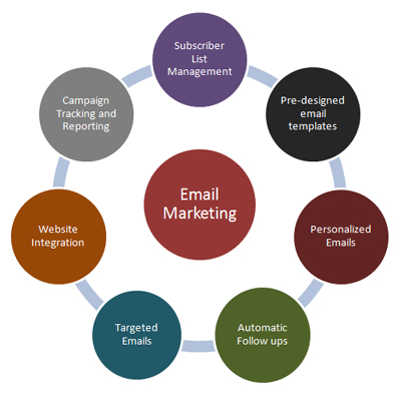Professional emails start with customizable templates
Overview
Email Marketing is directly marketing a commercial message to a group of people using email. In its broadest sense,every email sent to a potential or current customer could be considered email marketing. It usually involves using email to send ads, request business, or solicit sales or donations, and is meant to build loyalty, trust, or brand awareness.
- More effective than social media for customer acquisition
- Economic and cost effective
- Personal and customizable
- Action oriented
- Measurable
- Email enables immediate, direct communication, and is still the most efficient and flexible online channel.
- Mobile devices allow people to check their email on a constant basis
Outline of Email Marketing

- Create Email Strategy
- Designing
- Content Preparation
- Prepare Email Database
- Sending Plan
- Review and Analysis
- Track Responses
- Reporting
- Policy Protection
Services
- Responsive Templates: Create stunning emails ready to engage on any device. Looks great on a desktop, laptop, tablet or smartphone, on any browser or any inbox client.
- A/B Testing: Test Subject Lines, From Names, Send Times or even Campaign vs. Campaign to see how your subscribers are likely to react to your emails based on opens and/or clicks.
- Autoresponders: Drip email campaigns set to send based on the triggers you determine to help nurture relationships with your subscribers, send welcome campaigns and take them on the customer journey of your choosing.
- RSS Email Campaigns: Populate email campaigns directly from your blog, keeping subscribers up-to-date and entice them back to your site.
- Email Delivery Management: The Benchmark Email deliverability team works hard with partners like Return Path and the Email Sender & Provider Coalition to help your emails hit the inbox.
- Signup Forms: Grow your email lists by creating easily embeddable signup forms to be placed anywhere potentials subscribers may frequent such as your website or Facebook page.
- Surveys & Polls: Gain valuable feedback from your subscribers and get the answers you need to help your business.
- Google Analytics: See the success of your email campaigns by tracking your campaigns through to your site and ultimately conversions. Discover what’s working along each step of your funnel while testing and improving to deliver greater ROI.
Process

- Validate Email Segmentation Data With Website Data: This allows you to discover if these segments behaved in the expected manner using data that monitors user behavior from when they arrive on a site to when they leave.
- Create an Improved Website Experience With Email Marketing: Thanks to the vastly improved technology at your fingertips, it is now possible to segment visitors who come from your email marketing strategy. With this information, you can discover their interests and create content tailored to their specific needs.
- Analyze Customer Relationship Management (CRM) and Email Engagement: You can place an identifier in your email campaign’s URL; just make sure it is specifically created for an individual. Then you can match up this person to segments defined in the Customer Relationship Management file.
- Testing & Targeting: Test the content on the predefined email segments by sending them to a specific page on your website from your emails. Try optimizing your landing pages and emails in one test and combine the data to get a better overview of customer behavior. Since more emails are opened on mobile devices than desktops, it is a good idea to test your website’s mobile landing pages.
